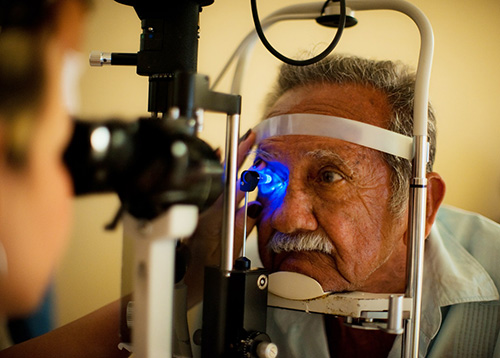Contents
Early eye pain and discomfort can indicate the need to implement natural remedies for glaucoma. The pain and discomfort typically appear in the morning, followed by blurred vision, halos around light sources, an inability to adjust to darker conditions, and peripheral vision loss, which results in tunnel vision.
Glaucoma Causes

Fluid is continually being produced in the eyeball. Also, just as frequently, it is draining out. The balance is called intraocular pressure. Normal pressure comprises fifteen to twenty millimeters of mercury, but glaucoma levels may reach forty or more.
The increased pressure, unless relieved, will eventually damage the optic nerve and produce blindness. Glaucoma is the second primary cause of blindness. There are several types of glaucoma. This condition is more prevalent in blacks than whites. Unfortunately, it tends to run in families, is more common in women than men, and primarily affects people over forty.
People with diabetes are more prone to glaucoma. About three percent of those over sixty-five have it. About 60,000 Americans are legally blind from this disorder.
There is no evidence that vision restoration due to glaucoma-caused nerve damage is possible. However, there are specific things that can be done to slow or stop the advance of the disease.
According to nutritionist Nathan Pritikin, glaucoma is caused by the buildup of atherosclerotic plaque within the eye caused by the overconsumption of saturated fats.
Natural Remedies for Glaucoma
Diet

- Dietetic problems are among the most common causes of glaucoma. These include overeating, eating the wrong foods, and not eating the right ones. One must eat a raw diet, which should be rich in vitamin C. Studies reveal that vitamin C (2000 mg or more daily) reduces intraocular pressure.
- The diet should include betaine HCL, vitamin A, vitamin B2, and nourishing, natural food—but not too much. Moderation is key!
- The diet should include antioxidant foods, which lower intraocular pressure. Vitamin B12 helps prevent the pressure from worsening. Coenzyme Q10 (3 mg daily) also helps lower intraocular pressure. Take it with vitamin E (400 mg daily).
- Omega-3 fatty acids help unclog the eye’s drainage system so fluid can adequately leak out, reducing pressure. For this purpose, take two tablespoons of flaxseed oil (1000 mg) every day.
- Alpha-linolenic acid (500 mg daily), best taken with magnesium (500 mg daily) and vitamin C (1500 mg daily), also helps lower blood pressure.
- Magnesium dilates blood vessels. One research found that people given 245 mg daily experienced some improvement within four weeks.
- A research study found that 17 of 26 people who took the bioflavonoid rutin (20 mg, 3 times per day) showed definite improvement.
- Less than one milligram of melatonin, taken before retiring, helps reduce pressure increases while you sleep.
- Consume whole, unprocessed foods, especially fresh fruits and vegetables. Eat whole grains, nuts, and legumes.
- Avoid saturated fatty foods such as meat, dairy products, grease, and most commercial vegetable oils. Instead, use raw flaxseed oil or wheat germ oil.
- Food “allergies” (eating foods that do not agree with the system) can frequently cause the disorder. The most common ones in glaucoma patients are eggs, chocolate, and onions.
- Perform a pulse test to discover which foods may be causing your problems. You can also purchase a tonometer to immediately test your eyeball pressure in response to what you just ate.
- Higher blood sugar levels increase pressure.
- Avoid coffee, tobacco, tea, alcohol, and all junk and processed foods. Smoking damages the eyes, which have glaucoma. Tobacco constricts eye blood vessels and increases intraocular pressure. Avoid spicy foods.
- Abstain from excessive intake of fluids (milk, juice, water, etc.) at any one time. Drink only small amounts, only an hour apart. But drink at least 48 ounces daily.
Herbs
- Jaborandi comes from a tropical tree in South America. It has been used to treat glaucoma for hundreds of years. The active ingredient is pilocarpine, which reduces intraocular pressure.
- Oregano is one of the richest herbs in antioxidants. One to two teaspoons of dried oregano in a cup of boiling water lowers intraocular pressure.
- Kaffir potato contains forskolin, which lowers the pressure of the eyes. Taken in drops, it reduces it in just one hour, reaches its peak in two hours, and continues for five hours.
- Pansy flowers contain rutin, which lowers pressure.
- Warm fennel herb, alternated with chamomile and eyebright, is helpful. Apply as eyewash in an eyecup or three drops to each eye three times daily.
- Here is a Chinese herbal formula for glaucoma: Mix one ounce each of tinctures of dandelion, ginkgo, milk thistle, eyebright, coleus, and bilberry in a large bottle. Take one teaspoon two times daily for three to six months.
- Research studies found that the root of Coleus forskolin contains forskolin, which reduces intraocular pressure. Salvia miltiorrhiza root also does this. Both are Chinese herbs.
- Avoid bloodroot. Its active ingredient, sanguinarine (used in toothpaste and mouthwashes), increases intraocular pressure.
Other Natural Remedies for Glaucoma

- Moderate, daily outdoor exercise helps reduce pressure.
- If anxiety seems to be a cause, increase the B complex intake. Avoid stress, worry, anger, and fear. Cultivate a tranquil, restful lifestyle. Significant temperature changes (as found in northern areas) are a source of stress. Avoiding stress would help.
- Abstain from heavy lifting, pulling, etc. Avoid constipation. Straining at the stool increases eye pressure (as does diarrhea). Maintain a slight, mild laxative effect. Keep away from sitting or standing still for long periods. Lying face down significantly on the hands dramatically increases pressure.
- Increased blood pressure brings increased pressure within the eyeball. Keep your blood pressure down!
- Fill a large basin with ice-cold water. Immerse both eyes in the water and rapidly blink your eyes open and shut five to ten times. Rest. Then repeat two to three times. Do this two times a day.
- Apply an ice-cold moist, folded washcloth (or towel) for two to three minutes, rest for one minute, and reapply three to four times. Repeat two times daily.
- Place a warm (not hot) folded towel over both eyes for three minutes. Then apply an ice-cold cloth for thirty seconds. Repeat three times, ending with a cold cloth.
- Do not use the eyes intensively for extended periods (TV viewing or excessive reading).
- Motion sickness medication patches increase eyeball pressure.
- Those with glaucoma do well to remain under the care of a professional. Every time the pressure increases, a little more eyesight is permanently lost.
Health Disclaimer: The information on this website is for educational uses only and is not a substitute for professional medical advice. Always consult an authorized healthcare provider for any health concerns before using any herbal or natural remedy. We do not establish, treat, cure, or prevent any disease. Reliance on any material from this website is solely at your own risk. We are not responsible for any adverse effects resulting from the use of information or products mentioned on this website.
REFERENCES
- Vance Ferrell Harold M. Cherne, M.D. The Natural Remedies Encyclopedia [Book]. – Altamont, TN: Harvestime Books, 2010. – Vol. Seventh Edition: 7: pp. 402, 403, 404. [Natural remedies for glaucoma]
- National Center for Complementary and Integrative Health (NCCIH): https://www.nccih.nih.gov/health/ginkgo
- Review of clinical studies: https://www.ncbi.nlm.nih.gov/pmc/articles/PMC3166166
- National Institutes of Health (NIH): https://www.ncbi.nlm.nih.gov/pmc/articles/PMC4550075
- Review of bilberry effects: https://www.ncbi.nlm.nih.gov/pmc/articles/PMC5380180
- American Academy of Ophthalmology (AAO) on marijuana and glaucoma: https://www.aao.org/eye-health/tips-prevention/medical-marijuana-glaucoma-treament
- National Eye Institute (NEI): https://www.nei.nih.gov/learn-about-eye-health/eye-conditions-and-diseases/glaucoma
- Review of antioxidants for glaucoma: https://www.ncbi.nlm.nih.gov/pmc/articles/PMC6213413
- National Eye Institute (NEI): https://www.nei.nih.gov/research/clinical-trials
- Glaucoma Research Foundation: https://www.glaucoma.org/research
Last update on 2025-06-04 / Affiliate links / Images from Amazon Product Advertising API





